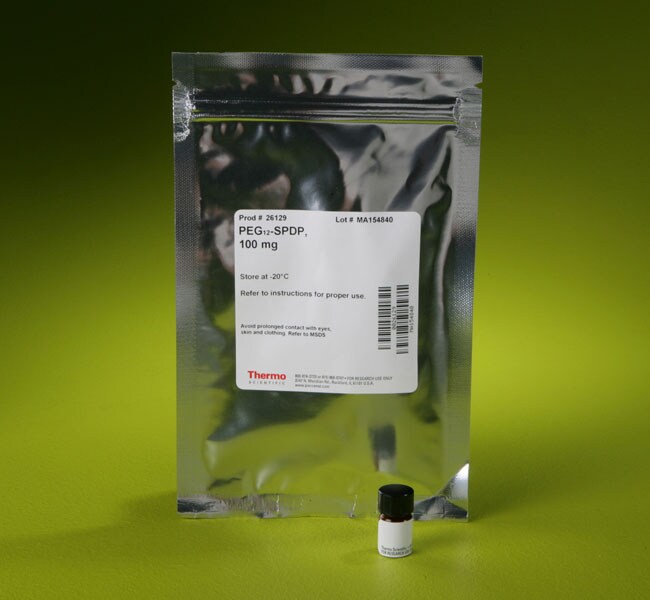
Thermo Scientific Pierce PEG12-SPDP is a multifunctional crosslinker for protein conjugation via amine-to-amine or amine-to-sulfhydryl crosslinks that contain a 12-unit polyethylene glycol (PEG) group and a reducible (cleavable) disulfide bond.
Features of PEG12-SPDP:
• Efficient amine conjugation—NHS ester provides effective conjugation to lysines, N-termini of peptides and other primary amines
• Reversible sulfhydryl conjugation—pyridyldithiol group enables disulfide linkage with reduced cysteines and other sulfhydryl groups, providing a stable but cleavable bond
• Polyethylene glycol—PEG groups are flexible, non-immunogenic, hydrophilic, and often enhance the solubility of attached molecules
• Spacer arm—connects primary amines and sulfhydryl targets at distances up to 54.1 angstroms; compare to PEG4-SPDP (25.7 angstroms)
SPDP-type reagents have an amine-reactive N-hydroxysuccinimide (NHS) ester at one end and a suflhydryl-reactive 2-pyridyldithio group at the opposite end. PEG12-SPDP has a 12-unit polyethylene glycol spacer arm, which confers greater solubility to the crosslinker and linked proteins compared to crosslinkers having only hydrocarbon spacers. Pyridyldithiol reagents produce disulfide-containing linkages that can be cleaved with reducing agents such as dithiothreitol (DTT). Crosslinking experiments with SPDP reagents are not limited to those involving proteins. Any of a variety of molecules with primary amines and sulfhydryl groups can be modified or crosslinked using an SPDP reagent.
Conjugation of SPDP reagents to primary amines reactions via the NHS ester is most commonly performed at pH 7 to 8 in phosphate, carbonate/bicarbonate or borate buffer. Other buffers that do not contain primary amines (or thiols or disulfide reducing reagents—see the sulfhydryl reactivity discussion) are also effective.
Reaction with the sulfhydryl-reactive pyridyldithio group can be performed with (simultaneously) or following the amine reaction, and it occurs optimally at pH 7 to 8. The reaction results in pyridine-2-thione displacement, the concentration of which can be determined by measuring the absorbance at 343nm. Reaction buffers must be free of thiols and disulfide reducing agents until quenching or reduction of the 2-pyridyldithio is desired.
Product References:
Crosslinker Application Guide -- search for recent literature references for this product
Related Products
PEG4-SPDP (PEGylated, long-chain SPDP crosslinker)
SPDP (succinimidyl 3-(2-pyridyldithio)propionate)
| Code | Description |
|---|---|
| 26129 | Catalog Number: 26129 |

